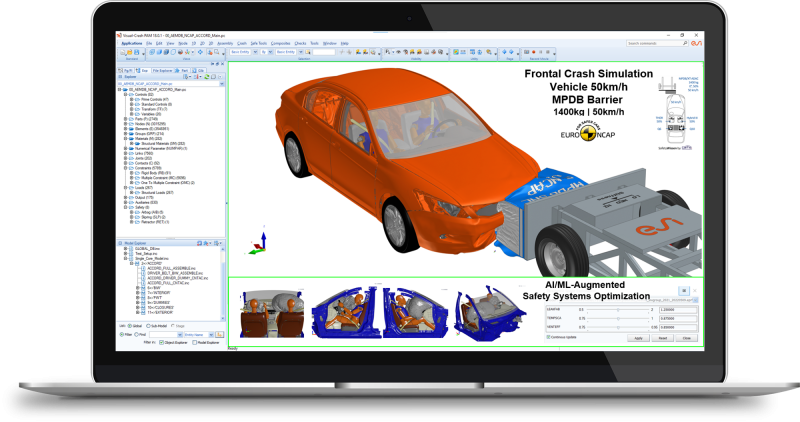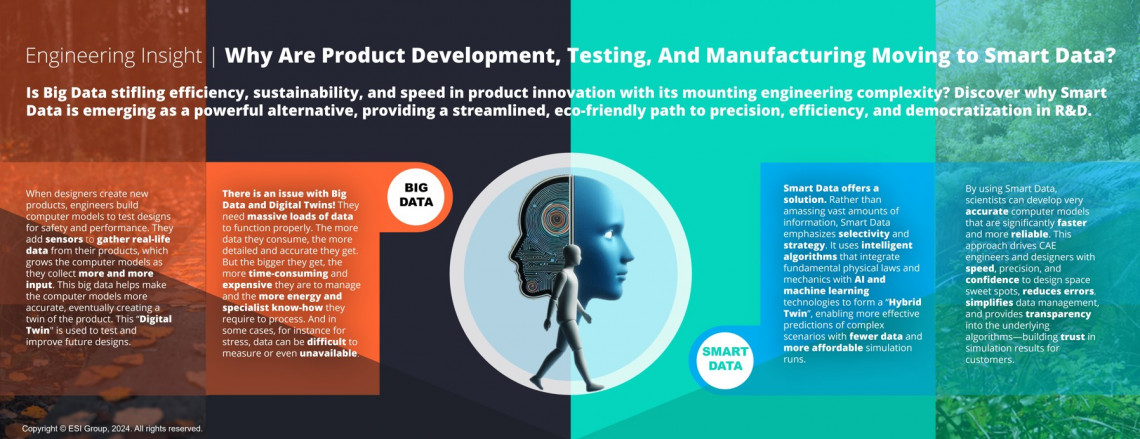The Smart Data Revolution: Why Product Testing Needs to Overcome the Big Data Mindset
Blending the precision of physics-based models with the adaptability of AI-based data-driven approaches

In today's digital age, the conversation around data has largely focused on one principle: more. More data is collected, stored, and analyzed than ever before, leading to the rise of "big data" as a critical resource across various fields, from finance to manufacturing. However, as businesses and industries face the complexities of managing and utilizing this vast information, another approach is emerging that challenges the traditional "bigger is better" mindset: "smart data." This method promises to reshape our approach to data and artificial intelligence (AI). Let's make sense of the difference between big data technology vs. smart data.
What is the Difference And Why Are Product Development, Testing And Manufacturing Moving to Smart Data?
Big data emphasizes scale, involving massive datasets that can include everything from customer purchase histories to real-time sensor data. The appeal of big data lies in the potential insights on product performance and functionality that can be derived from vast variety of information. Industries use this approach to create predictive models, so-called 'digital twins' to validate the behavior of next generation products e.g. in terms of quality, robustness, and safety. However, managing and analyzing such enormous amounts of data is costly, time-consuming, and resource-intensive. Often, much of the collected data is redundant or irrelevant, adding noise rather than value. Additionally, in certain engineering fields like stress, some critical data may be difficult to measure or unavailable.
Smart data shifts the focus from quantity to quality. Rather than amassing vast amounts of information, smart data emphasizes selectivity and strategy. It creates intelligent algorithms that integrates fundamental physical laws and mechanics with AI machine learning technologies, forming what is known as a “hybrid twin.” This approach combines digital and physical insights to enhance the accuracy and reliability of simulations, making it possible to predict complex scenarios more effectively with fewer data points.
This shift is particularly transformative for industries that rely on data for innovation and decision-making. Engineering, with its rich history of mechanics and material physics, is an ideal candidate for leveraging hybrid twins based on smart data. Why? By combining domain-specific expertise with data from machine learning, scientists can develop computer models that are not only more precise but also faster and more reliable. This dual approach enhances model accuracy, reduces errors, eases data management, and provides transparancy into the underlying algorithms, which is key for building trust in simulation results amongst the customer base. Ultimately, it creates a significant competitive advantage by facilitating the production of certification-ready prototypes right from the start of the production process.
“We must put the right data in the right place at the right moment, blending the precision of physics-based models with the adaptability of data-driven approaches. This is what we call 'hybrid artificial intelligence,' a concept introduced by ESI years ago as the Hybrid Twin.”
Prof. Francisco ChinestaScientific Director, ESI Group
What is an Example of How Major Manufacturing Companies Analyze And Utilize Smart Data
A major driving force behind the smart data movement is the integration of AI. By combining machine learning with human domain-specific knowledge—such as physics and chemistry—along with a few real-world experimental data points, engineers can answer complex performance-related questions by creating more accurate and efficient simulation models. This approach reduces reliance on massive datasets by using smaller, targeted data that is informed by expert knowledge. Prof. Francisco Chinesta explains that this method "bridges the gap between predictions and reality" by focusing on the most critical data. Understanding the underlying mechanisms allows companies to optimize their data collection efforts, achieving more precise results and valuable, actionable insights with less information.
Originally developed and tested for smart cities in the DESCARTES* research project, the smart data approach has proven valuable in manufacturing industries, such as automotive, where engineers combine hybrid AI models with physics-based simulations to predict vehicle-side member reinforcement via crash simulation or improve processes like laser brazing and weld quality control with fewer data points.
Engineering is one of the fields where hybrid AI can be very useful and, I would say, mandatory today to be more efficient.
Aurélie Jean, Computational Scientist, Author and founder of IN SILICO VERITASat ESI TALKS 2024
To explore more about the specific value of smart data, watch this year's ESI TALKS panel discussion where Francisco Chinesta and other leading minds in this field discuss, how smart data enable you to innovate faster, more cost-effectively, and at a larger scale.

Hybrid Twin for Airbag Simulation based on smart data, (C) ESI Group 2024
What are the Benefits of Smart Data Analysis for Modern Factory R&D
Transitioning from big data to smart data offers several advantages for research teams in organizations:
- Efficiency and Cost-Effectiveness: Collecting and processing lower data volumes reduces costs related to data storage, infrastructure, and computation. This efficiency supports more sustainable business operations and frees resources for innovation and growth.
- Improved Decision-Making: Smart data enhances the explainability of AI models, making it easier to trust outcomes and detect errors or biases. This transparency is crucial in industries with significant operational consequences, such as manufacturing and engineering.
- Environmental Impact: Big data operations often consume vast amounts of energy, contributing to carbon emissions. By focusing on smaller, relevant datasets, smart data reduces energy consumption and promotes eco-friendly practices in modern organizations.
- Real-Time Applications: Smart data excels in real-time applications, such as smart cities or smart mobility devices, where systems must respond quickly and accurately to changes. Smart data enables more efficient and effective real-time operations.
“The Hybrid Twin is no longer a future concept; it's here today. With it, we can develop faster, better, and cheaper.”
Prof. Francisco ChinestaScientific Director, ESI Group
What is the Path to Smart Data?
For engineering and research organizations transitioning from big data to smart data, the journey begins with a shift in mindset. Instead of collecting data indiscriminately, businesses should prioritize goal-oriented data collection. This involves identifying specific insights needed and gathering only the data that supports these objectives. Investing in hybrid AI models is another crucial step. By integrating domain-expert knowledge and fundamental physical laws into AI systems, companies can reduce reliance on large datasets while improving prediction accuracy and reliability.
Conclusion: We Don't Need Much Data But the Right One to Drive Valueable Insights
As industries evolve in the age of AI and digitalization, the shift from big data to the use of smart data represents a critical change. Smart data alone is often sufficient for performance validation, streamlining development processes for manufacturing industries and reducing the need for excessive data collection from physical prototype testing. This ultimately enables companies to not only improve their business operations but also contribute to a more responsible and sustainable future. In a nutshell: State-of-the-art innovation practices are not about continuously gathering more big data—it's about having the right data in the right place in real-time.
* The DESCARTES program, a Franco-Singaporean initiative, focuses on leveraging hybrid digital and physical models—Hybrid Twins—to advance smart, ethical, and sustainable urban development. This collaboration aims to integrate AI and advanced simulations into city planning to enhance infrastructure resilience and sustfainability.
Denise is a seasoned media and communication professional with over 15 years of experience in the IT industry, spanning logistics and asset management software to system simulation and virtual prototyping (CAE & PLM). With a deep passion for technological innovation and sustainability, Denise is a steadfast ambassador and fervent advocate for Virtual Prototyping, utilizing her extensive expertise to steer companies through the conundrum of terminology in the era of digital and AI. As the Sr. Marketing Content Specialist at ESI, Denise creates insightful publications that help businesses understand the technologies, methodologies, and value of shifting from physical to virtual prototype testing – a transition that is facilitated through the utilization of CAE software, augmented with immersive tools and hybrid AI technologies.
